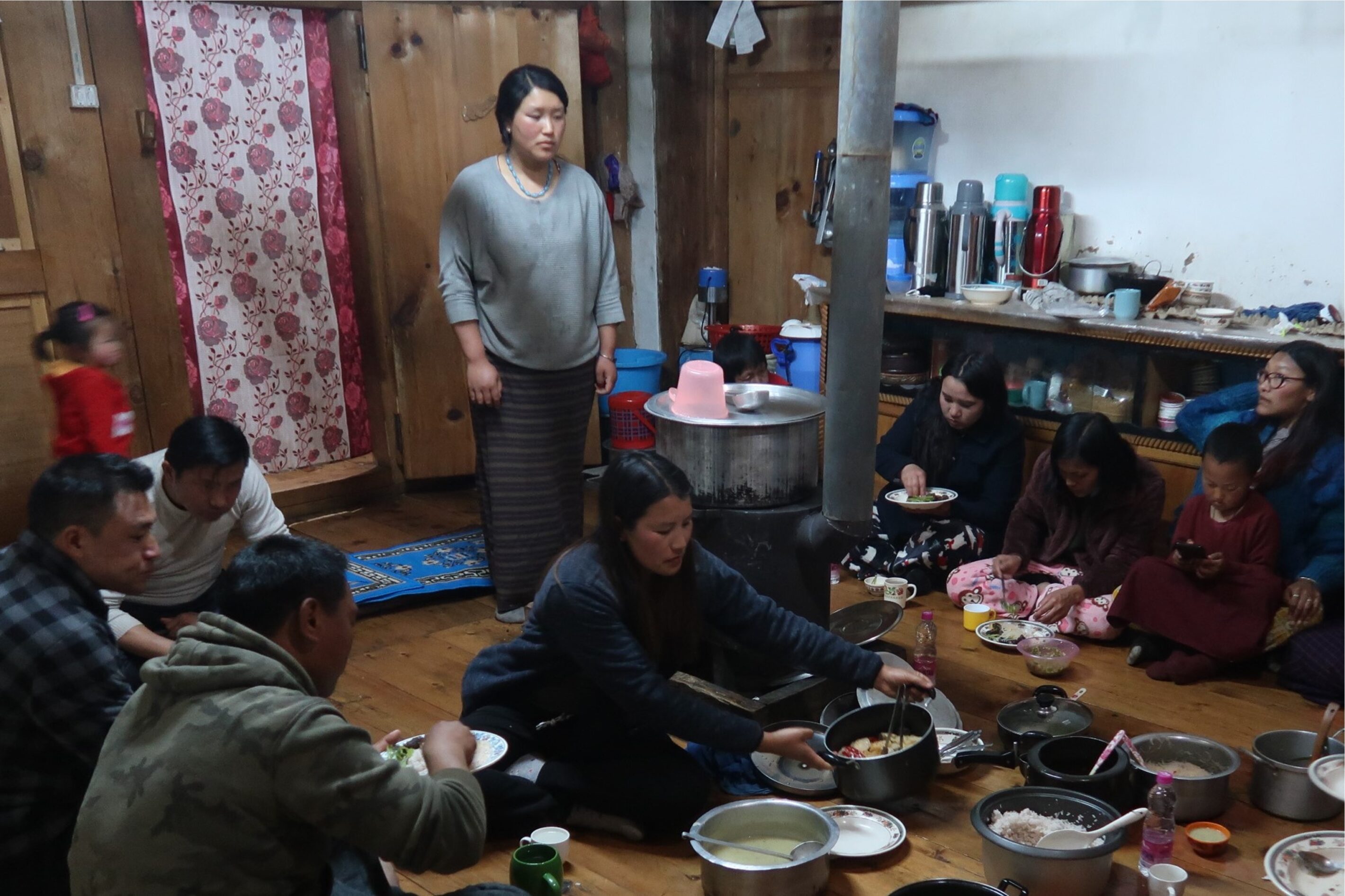
Bhutan's
Eating with Hands
English translation : Yui Okada, Aki Yahata
The Kingdom of Bhutan (hereinafter referred to as Bhutan), located in South Asia, is one of the countries that still retains a culture of eating with hands. The practice of taking food directly to the mouth with one’s hands is widely observed throughout the country and is a characteristic of the country’s dining landscape.
Bhutan was unified under the Druk sect, a sect of the Kagyu sect of Tibetan Buddhism, and began its journey as a country in the first half of the 17th century. Assumedly, the culture of eating with hands had already been established by that time, yet to clarify the historical background of the culture in the country is difficult. Even Bhutanese experts say, “It has been like this for a long time.” Presumably, there is an influence from neighboring Tibet and India, the details of the history are not certain. This article summarizes the author’s knowledge about the modern Bhutanese culture of eating with hands and the related information, in three chapters: Eating with hands captured in videos, Bhutanese cuisine, and Bhutan’s way of eating with hands.
Eating with hands captured in videos
You can see Bhutanese dining style—eating with hands—from various periods in following videos: Films taken around Bhutan in 1933 and 1934 by Frederick Williamson, the Parliamentary Secretary of Sikkim in British India; An official video recording of Government of India Prime Minister Visits Bhutan showing when Jawaharlal Nehru—the Prime Minister of India at that time—visited Bhutan in 1958; Small Countries, Vol. 5: The Unexplored Himalayas, broadcasted on NHK on 2 November 1967; Teaching Bhutanese agriculture in an unexplored region from Japanese in the World, broadcast on MBS on 18 January 1968; Coronation Ceremony in the Unexplored Region of Bhutan from NHK Correspondent’s Report, 25 June 1974; NHK program, The Magnificent History Of Bhutan’s Royal Family from Asia’s Monarchies, dubbed and edited by Japanese broadcast and aired on BS11’s Best of Document in 2012 under the title Asian Monarchy: The Past And Future Of Monarchy In Bhutan.; Bhutan, In Search of a Celestial Kingdom from Themes Around the World, produced by the Korean Educational Broadcasting System (EBS) in 2014; Bhutan: Change Comes to the Happy Kingdom from DW Documentary, a documentary created by a German international broadcasting entity, Deutsche Welle (DW), released in 2020.
In Japan, the Bhutanese film Lunana: A Yak in the Classroom was released nationwide in movie theaters from April 2021 and this film was nominated for the 94th Academy Awards for Best International Feature Film in 2022. In this film you can find people eating with their hands multiple times. A city boy protagonist Ugyen appears on the screen having meals with his friends using a spoon in the capital, Thimphu. However, on the way to/at Lunana—an unexplored village at an altitude of 4,800 meters, which requires an 8-day hike to reach, you can see him naturally use his hands when he eats with locals. This is very interesting.
As far as I know, the oldest footage of eating with hands in Bhutan is shown on Williamson Reel No.6 / The Tibetan and Himalayan Digital Library from the film collection of Frederick Williamson, shot in 1933 in Bumthang. There is a scene that male servants are forming a line to eat together. Sitting cross-legged, they’re being served rice on a cloth called a “torey” and soup as a side dish in a vessel (cup) called “phob.” In the same film collection, you can find them eating with hands in Williamson Reel No. 13 / The Tibetan and Himalayan Digital Library, which was filmed in the west of Bhutan, Haa in 1934.
An official footage was shot when the Prime Minister Nehru visited western Bhutan and it shows his senior government officials, including Tamsin Jakar, are eating rice with their hands from bamboo plate called a “bangchung” (also known as a “bangchu” or “pongchu“—also used as a lunch box by covering the plate with a lid.) Meanwhile, Nehru and others use spoons to eat during the journey from Haa to Paro over a pass.
Small Countries, Vol. 5: The Unexplored Himalayas, broadcasted on NHK (1967) and Coronation Ceremony in the Unexplored Region of Bhutan from NHK Correspondent’s Report (1974) vividly recorded the habit of farmers eating with their hands in Paro at the time. Farmers take a bite-sized portion of rice from a toray or bangchung with his right or left hand and clasps it in his palm like a tightly formed cylinder-shaped sushi. Then, they dip the rice into “ema datshi“, a cheese stew with chili peppers. The narration for this scene is as follows (highlighted by the author),
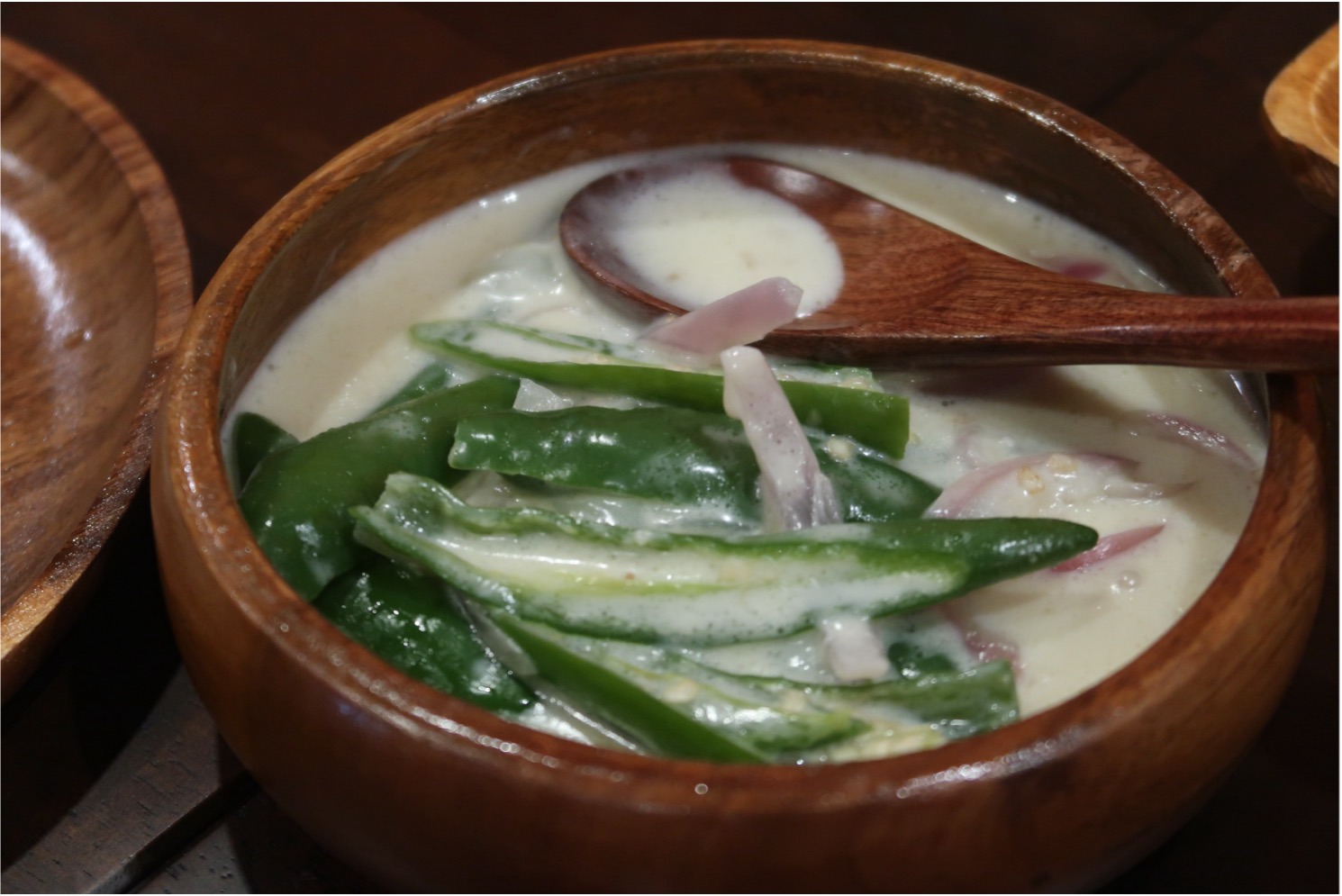
It’s lunchtime. During the busy farming season, they seem to spend their lunch time outside. The rice looks exactly like “sekihan,” which is Japanese red bean rice. And today’s side dish looks like a stew with chili peppers. They don’t use chopsticks. They clasp the rice like “nigiri sushi” and dip it in the soup of side dish to eat. Bhutanese favorites are beef and meat from yak, as well as butter and cheese made from cow or yak milk. After the meal, they have a cup of tea. The landscape resembles a Japanese farming village.
Coronation Ceremony in the Unexplored Region of Bhutan shows cooking by a farm family and lunch time for people who came to help with the farmwork outside. The image of a woman eating a smile on her face and looking at the camera, perhaps embarrassed, is captivating. The narration tells a glimpse of labor situation in Bhutan while showing scenes of 20 or more people having a meal together:
The stove they use is similar to the one we used to have in rural areas of Japan. Rice is equivalent of red bean rice in Japan. (Omitted) Meals for the helpers are served outside. It includes rice, dried beef or yak meat, cheese, and vegetables. This meal is part of their wage, and the wage needs to be equivalent to 500~600 yen/day together with three meals and two snacks. Otherwise, they won’t come back from next year. Bhutan has a small population, and there is a labor shortage not only in agriculture but in general. To fill this labor shortage, a lot of migrant workers from Nepal and Tibet flood in. They are categorized into lower working class in Bhutan and work with lower wages than Bhutanese.
In Teaching Bhutanese agriculture in an unexplored region from Japanese in the World, broadcasted on MBS (1968), a program follows Mr. Keiji Nishioka and his wife Satoko who had led Bhutanese agriculture since 1964. The camera captured a gesture which is taking a small amount (a pinch) of rice and throwing it quickly at the back before starting the meal. This is called “choeshey“, a kind of offering to the spirits and gods around oneself and performed not only with food but also with drinks. A deeper and longer prayer before a meal is called “tomchoe“. You can find tomchoe in The Magnificent History Of Bhutan’s Royal Family from Asia’s Monarchies. Students of a monastic school located in Punakha in western region perform it. Choeshey can be said a simplified version of tomchoe. The narration for this scene is as follows (highlighted by the author),
Long, slender reddish rice. As you clench and clench repeatedly, it becomes sticky and becomes like a dumpling.The fragrant rich rice is cooked with butter and dried saffron stamens. Dried beef, mutton and pork are stewed for a side dish. Tea has a uniquely flavor seasoned with salt and butter melted in. They do not eat anything that flies in the sky or lives in water because they are considered as messengers of gods. Therefore, livestock such as cows, pigs, sheep, and dried meat of animals caught in the mountains are served within side dishes. Protein was richer than that of Japan, but with Mr. Nishioka’s effort, vegetables have been introduced to their cooking and widen the range of dietary options.
The current dining scene is basically no difference from what is documented in these videos about 50 to 90 years ago. Of course, in line with modernization, you can see the use of utensils such as spoons and forks in restaurants in towns and school cafeterias at high schools or universities, and some people use them at home as well. Some young people think it’s more civilized to use utensils (eating with hands is barbaric), and there are a certain number of children who are accustomed to dine with utensils and not good at eating with hands. Basically, kids get familiar with how to use your hands at home. No training or education is given officially. Many of my Bhutanese acquaintances are like Ugyen, the protagonist of Lunana: A Yak in the Classroom. They choose to use utensils or hands according to the situation.
Although there is no clear scientific evidence, some say “Using metal utensils changes the taste of food. With your hands you can enjoy the flavor of the ingredients better.” or “It definitely tastes better with utensils.” Not only that, some mention “It’s cleaner to eat with utensils.” However, I , at least, have never heard the covid-19 pandemic or use of touchscreens like smartphones affected the habit of eating with hands.
By the way, in the official video of the Indian government, Prime Minister Visits Bhutan, there is a scene that the third king Jigme Dorji Wangchuck, his wife Kesang Choden Wangchuck, the second queen Pema Dechen Wangchuck and Jigme Palden Dorji, the Prime Minister back then, are having meals with cutlery, apart from the scene already mentioned above.
The NHK Correspondent Report also featured a newly opened restaurant in the capital Thimphu where people uncomfortably eat Chinese-style yakisoba “chow mein” with spoons (rather than forks) .These videos show the dawn of the use of utensils in Bhutan.
Bhutanese cuisine
Rice is the staple food for Bhutanese, and their basic meal consists of a large amount of rice with a small amount of side dishes. Domestic rice is mainly Japonica rice, which is round and short, and there are red and white varieties. Additionally Indica white rice produced in neighboring India is widely distributed in the country. White rice cooked with corn flour is common in the eastern part of the country. The cooking method in Bhutan is Hot Water Method: pour the rice into a large amount of boiling water to cook through, then discarding the water and steaming it. This differs from the general Japanese method where an appropriate amount of water is used, allowing the rice to absorb all the water. Since the rice is not sticky, it will not stick to your palms when you eat it with your hands.

For example, buckwheat has traditionally been cultivated in highlands such as Bumthang in the central region and Haa in the west where it was impossible to grow rice. Therefore, Bhutan also formed a culture of soba cuisine. A noodle dish “puta” made with buckwheat flour: there is no soup, but mixed with oil or butter, like abura soba−oiled ramen noodle in Japan, the buckwheat pancake “khuley“, buckwheat dumplings “dengo” and buckwheat dumplings “hoentay” which use buckwheat flour crusts, are typical examples. They are also generally eaten with the hands. Tibetan dishes such as “momo” (dumplings) and “thukpa” (noodles), as well as Indian and Nepalese dishes such as curry and dal (bean soup) are also commonly consumed. In particular, the southern region known as Lhotshampa, where many Nepalese people reside, may be considered as the curry cultural area.


Bhutanese cuisine, including ema datshi (‘ema’ refers to chili pepper and ‘datshi’ to cheese), which is always mentioned as a typical Bhutanese dish, is often stewed with a rich variety of vegetables and dairy products. Unlike in Japan where chili pepper is commonly used as spice, in Bhutan, it is treated as a vegetable, and holds a prominent place in the market due to its high sales volume and consumption. It is not certain when the introduction of chili peppers was and when the eating with hands culture took hold. Yet it is clear that chili peppers are now the most loved vegetable in Bhutan. The primary dairy product is cheese, available in a wide range of varieties and processing methods. In recent years, vegetarianism has seen an increase due to Buddhist beliefs and health-consciousness, although many dishes are still prepared with meat. Both vegetables and meat are often dried and stored, and this use of dried ingredients is also a unique feature of Bhutanese food culture.
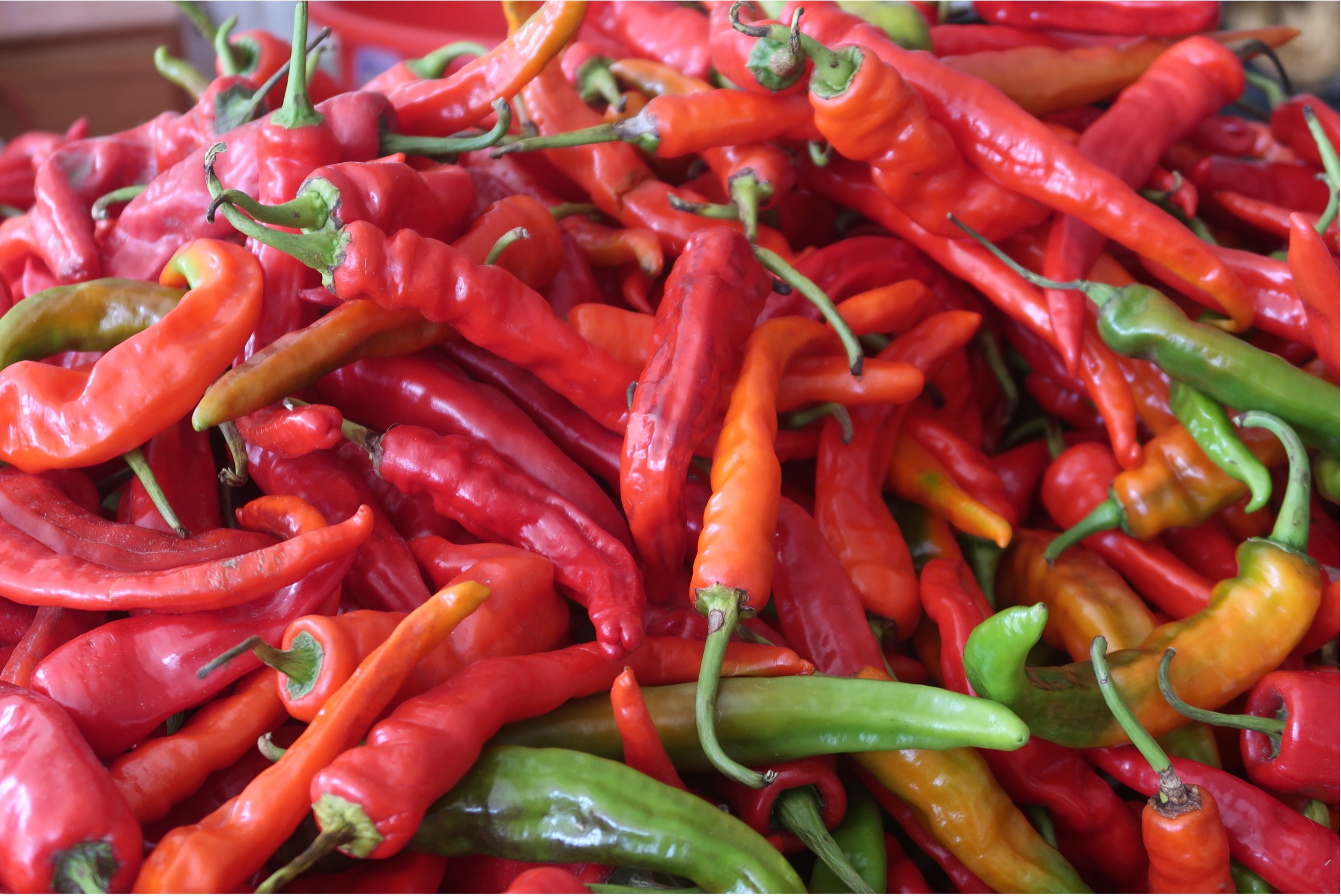
Vegetable-based stews, whether with or without cheese and chili pepper, are collectively known as “tshem.” Cheese stews have a variety of flavors; chili pepper is the primary ingredient and is complemented by potatoes, mushrooms, royal ferns, eggplant, cauliflower, asparagus and more. Meanwhile, meat-based stews commonly referred to as “paa” are a festive feast typically served when there are guests or during special occasions. There are various cuisines, like “phaksha paa” (‘phaksha‘ refers to pork and ‘paa‘ to lumps), “shikam paa” (dried pork and chili pepper), “norsha paa” (beef and chili pepper), “shakam paa” (dried beef and chili pepper).
As for tea, “suja“, a butter tea is made by simmering ground solid tea known as brick tea, and then stirring it with butter and salt, as well as “ngaja“, sweet milk tea are widely consumed. The latter seems to have spread rapidly in Bhutan over the past 30 years, possibly influenced by neighboring India. Tea snacks such as “zaw” (fried polished rice), “sip” (fried mashed hulled rice), and “geza sip” (fried mashed corn), are enjoyed either on their own or by softening them in tea.
There is a wide range of alcoholic beverages in Bhutan, including “chang” made by mixing malted rice with cereals, and “ara” which is distilled from chang. Additionally, beer, whisky, wine, gin-lime, brandy, vodka, rum and liqueurs are produced and sold domestically.

Bhutan’s way of eating with hands
Unlike neighboring countries such as India, Bhutan does not appear to have any specific left or right hand prohibitions. When eating with hands, right-handed people use their right hand and left-handed people primarily use their left hand. The other hand is used freely as necessary.
The basic form of family mealtimes in Bhutan involves sitting in a circle on the floor . Both men and women sit cross legged which is the official seating stance in the country. The posture is easily accommodated even wearing Bhutanese national dress, “gho” (for men) and “kira” (for women). Sitting with one knee erect or knees outstretched is considered against manners. The person in charge of serving food, usually the head of the family or his daughter, sits in the center of the circle, and uses utensils to pour food from the platter onto individual plates. The person who sits in the center is called “nangyi aum“, and the food is served in specific order. Generally the older man is served first.
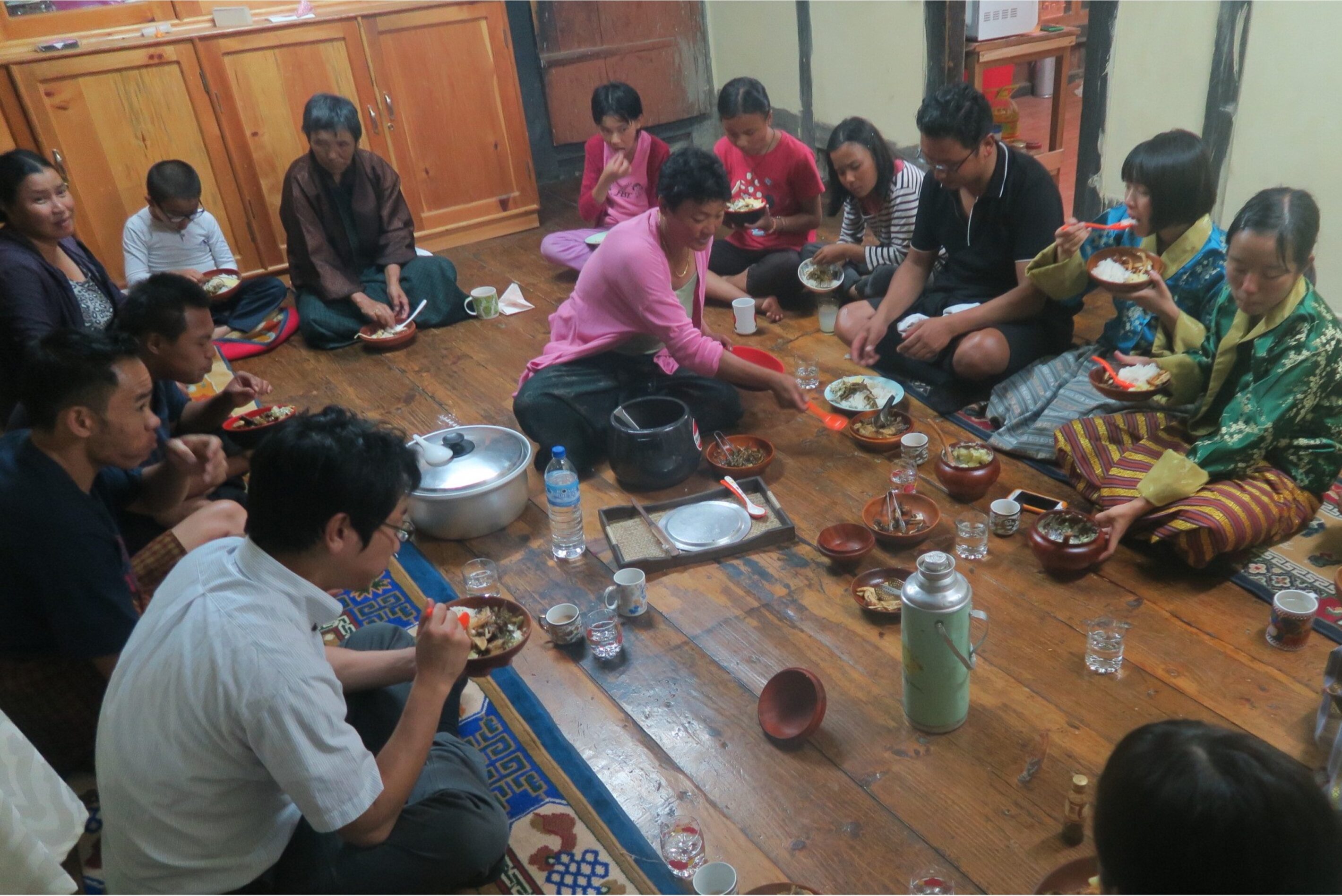
Plates are placed directly on the floor and they don’t use tables or something like a bed tray. Dishes may consist of rice (in some regions, buckwheat dishes such as khuley is served instead of rice) accompanied by one or two stewed vegetables such as ema datshi (tshem), and on special occasions, meat-based stew known as paa may be added. Traditionally, tableware, including dishes made from the aforementioned torey (cloth), bantung (bamboo) or lacquerware known collectively as dhapa, were used, but nowadays plastic plates are more common. When the food contains a lot of liquid, a small bowl is separately provided in addition to the plate with the rice.
Finger bowls are not used but instead, the dirt on the hand is commonly removed with a small amount of rice kneaded on the palm before the meal. The rice kneaded with dirt from the hands is left on the side and fed to pets such as dogs or cats, or simply discarded as waste. Some point this custom of “washing hands with rice” is a proof of Bhutan’s high rice harvest and affluent lifestyle.
As part of the religious practices associated with Tibetan Buddhism which is followed by three-quarters of the population, there is a custom of performing offerings and prayers before meals, as previously mentioned. It is called choeshey or tomchoe. As observed in the video, choeshey involves some individuals throwing a small amount of rice towards the back, while others place the rice on the floor. There appears to be no fixed formula of the ritual. With drinks such as tea or alcohol, you dip your finger tip (ring finger) lightly on the surface and a drip of liquid is flicked into the air. Tomche often includes kneading rice with fingertips conveying a prayer and creating a simple offering. When forming a contribution, sometimes soup of side dishes or drinks are added to make it easier to shape.
Previously highlighted narration stated as follows, “form the rice like ‘nigiri-sushi ’ and dip it in the soup of the side dish.” “As you clench and clench repeatedly, it becomes sticky and becomes like a dumpling.” When eating rice, start by taking one or two bites of rice using five fingers, then shape it into an easy-to-eat shape with the palm (this form of clenched rice is called “akham“). Enjoy this akham by dipping into the soup or pairing it with side dishes. However, if the rice is consumed without being soaked in the soup, occasionally the rice is directly conveyed into the mouth without shaping akham. Take the bowl with your hand to drink and eat soup directly out of it.
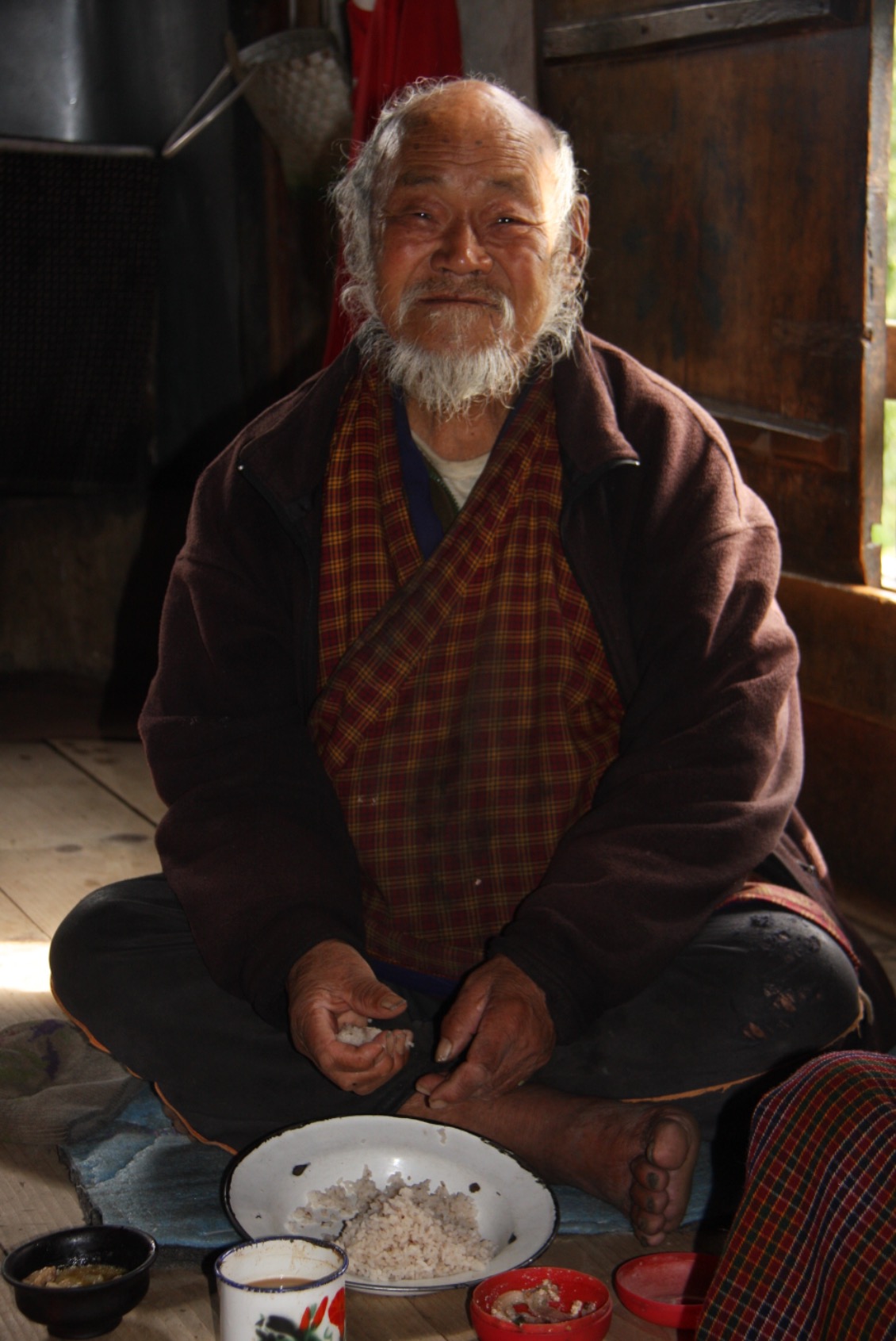
It is considered as a good manner to savor as quietly and noiselessly as possible, and beautiful to eat without spilling rice or getting grains of rice on the outside of the fingers. Licking fingers during or after the meal is not a good gesture, but some people actually do.

In Bhutan, along with the growing momentum to establish a national identity with national unity in mind, a set of rules of etiquette that Bhutanese should acquire has been organized and the training widely began in the 1980s. This etiquette, referred to as “Driglam Namzhag“, is especially focused on the differences in etiquette depending on the status and the position of individuals you are dealing with and the behavior in the public and it includes table manners. I’d like to conclude this article by sharing some supportive information about Bhutanese culture of eating with hands, drawing on the selected items from the Driglam Namzhag, manual published in 1999.
- When dining with dignitaries, place tableware on your lap and hold the bowl of soup with your left hand.
- Start the meal by picking up the rice and making akham.
- Spilling rice and putting food in the mouth back onto the plate is considered impolite.
- Do not crush bones with your teeth while eating.
- Do not blow on hot food to cool it down.
- When dining with dignitaries, bones should be kept in the pockets of gho (men’s traditional dress).
- When eating with dignitaries, use fingers to make meat into small pieces.
- When eating with dignitaries, hold the dishes until the dignitary finishes the meal.
- Licking the bowl is considered impolite.
- In regular situations, you can leave your own tableware on the floor.
- In regular situations, you may cut meat into small pieces with a knife.
- In regular situations, Gather bones in front of the right knee and take them when leaving the table.
- Hold the cup with your right hand when you drink tea.
- Hold the cup with your left hand when receiving zaw or sip. (zaw or sip should be received with the right hand).
- Do not eat zaw or sip dipped in the tea with your fingers.
- Licking the cup after drinking tea is considered impolite.
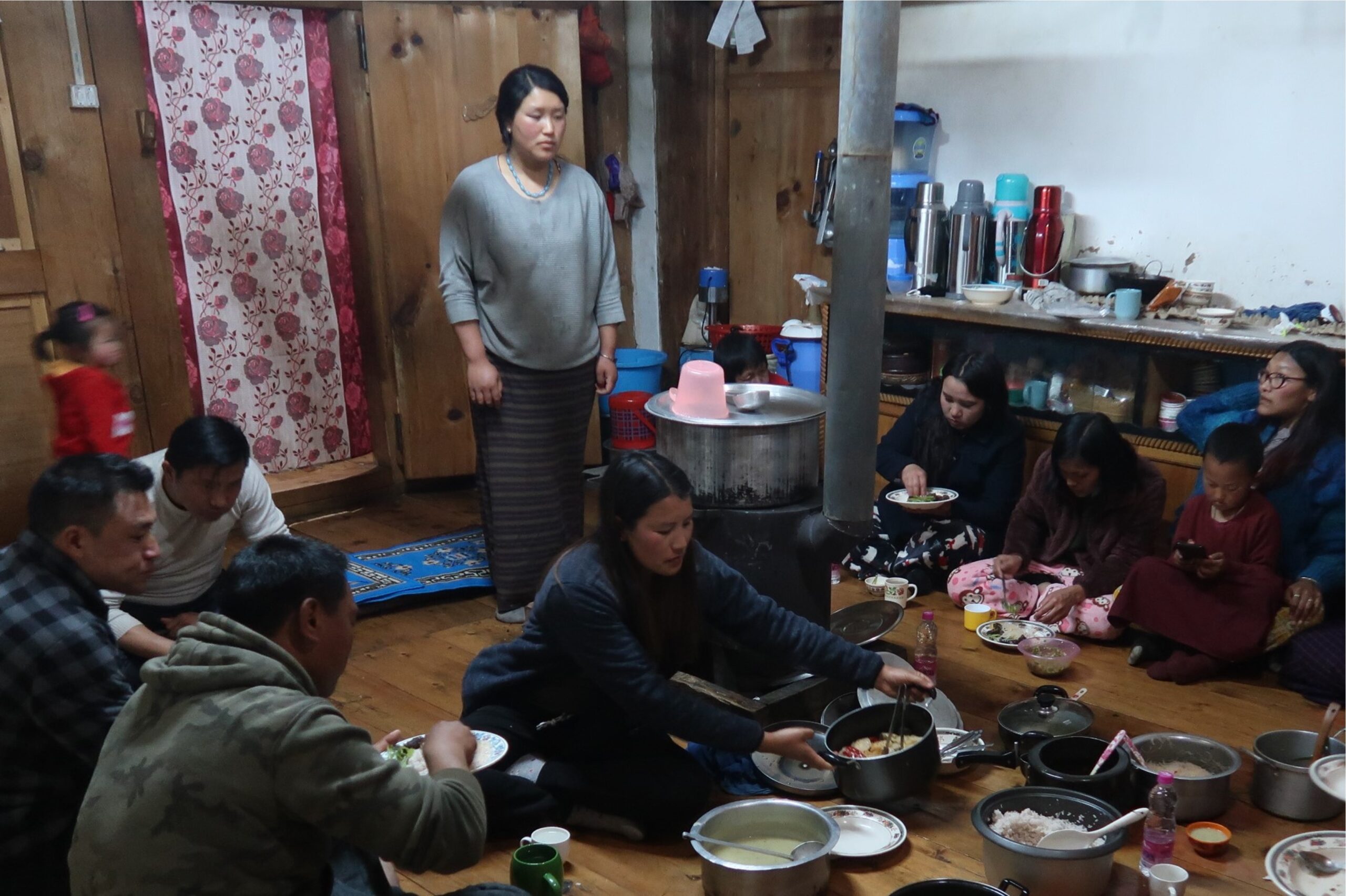
Refarence videos
- 『Bhutan, In Search of a Celestial Kingdom Part 4.Thimphu Tsechu, the Kingdom’s Festival』
- A meal scene at a monastery school appears in a Korean travelog program broadcasted in 2014. (24:40- approx. 1 min.) The scene shows making offerings with rice while chanting a prayer before eating. Ordinary people typically do not make such detailed offerings before every meal. (It is also possible that monks do not usually engage in offerings with this level of detail.)
- 『Bhutanese mukbang. Sikkam paa (dried pork)』
- A video of a Bhutanese woman cooking and eating with hands. Many videos of eating with hands are posted on this channel.
Profile

Takehiro Hirayama
Representative of the Japan Institute for Bhutan Studies (JIBS). He has served as a research fellow (DC2) of the Japan Society for the Promotion of Science (JSPS), a research associate at the Institute for Advanced Studies in Education (IASE), Faculty of Education and Integrated Arts and Sciences, Waseda University, an assistant professor at the Hirayama Ikuo Volunteer Center (WAVOC), Waseda University, and is currently a lecturer at Global Collaboration Center (GCC), Ochanomizu University. In addition to his research on Bhutan, he is working to create opportunities for interdisciplinary mutual improvement and establish networks through the various activities of JIBS, of which he is the representative. He is also a board member of the Japan Bhutan Friendship Association (JBFA) and the Japan Society for Bhutan Studies (JSBS).





Leave a
Comment